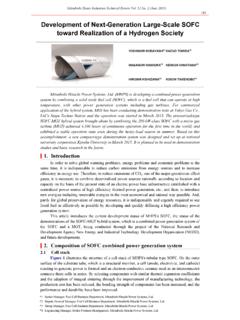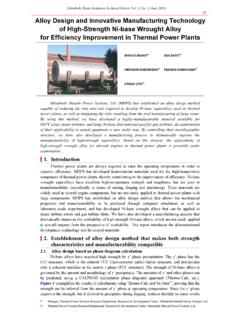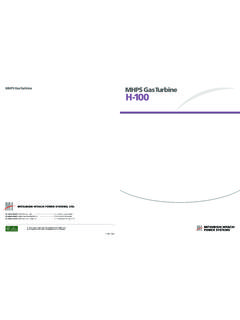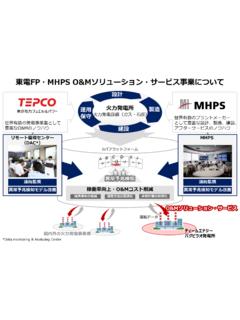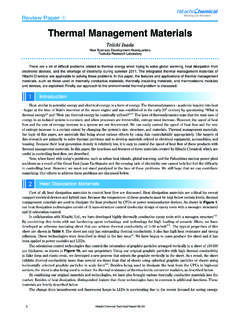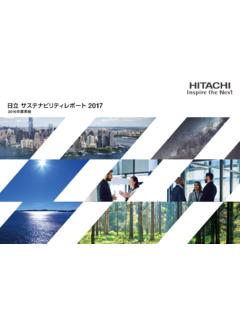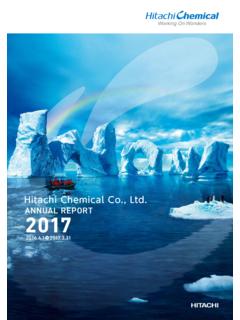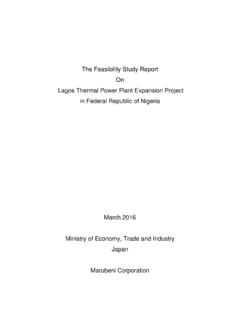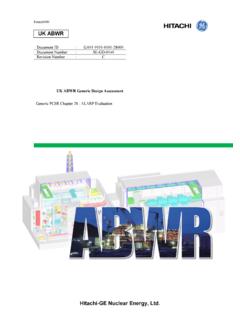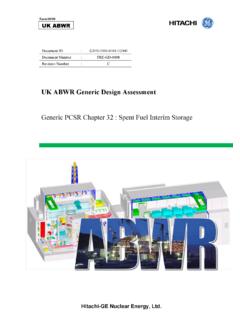Transcription of Mitsubishi Hitachi Power Systems Ltd. Boiler …
1 Mitsubishi Heavy Industries Technical Review Vol. 52 No. 2 (June 2015). 55. Mitsubishi Hitachi Power Systems Ltd. Boiler Business and Technology Development YASUHIRO UKEGUCHI*1 KAZUHITO SAKAI*1. SHIGEHARU KOKURYO*2 KAZUHIKO SAITO*3. TAKAYUKI SUTO*4 TAKATOSHI YAMASHITA*5. Mitsubishi Hitachi Power Systems , Ltd. (MHPS) was established by merging the thermal Power generation business sectors of the two companies: Mitsubishi Heavy Industries, Ltd. (MHI). and Hitachi , Ltd. ( Hitachi ). Both companies had separately pursued technologies for the effective and clean utilization of coal by employing their own firing Systems . In addition to their business histories regarding the development of such technologies and the latest technological trends, this report also addresses our future direction as MHPS in the development of Boiler technologies.
2 |1. Introduction Merging the thermal Power generation business sectors of MHI and Hitachi , MHPS was thus founded in February 2014. Before this consolidation, the two companies had separately developed and advanced their own technologies to realize the cleaner utilization of coal-derived energy, by employing circular or opposed firing Systems in thermal Power generation boilers. This report introduces the business histories of such technological development, along with the latest trends of clean coal technologies. Our business activities as MHPS for the development of Boiler technologies, which have been enhanced through the synergetic effects of the consolidation, are also reported. |2. Clean coal technologies Ultra-supercritical (USC) Power plants From the 1990s, the use of inexpensive coal as a fuel became common, increasing the need for establishing environmentally-sound Power plants.
3 Accordingly, MHPS improved the efficiency of steam Power generation by elevating the temperature and pressure of applicable steam conditions. The latest plants have enabled a steam condition called USC ( , exceeding both the pressure of MPag and the temperature of 593 C). USC Power generation is considered to be a technology for the realization of the highly efficient and environmentally-sound use of coal. USC. Power plants are becoming more common in other countries, as well as in Japan. Figure 1 shows the steam conditions of MHPS-supplied steam Power generation facilities and their operation commencement years. In 1968, we manufactured and installed our first supercritical (SC) oil-fired Boiler at Unit 3 of the Chita Thermal Power Station of Chubu Electric Power Co., Inc. (500 MW, MPag and 538/538 C) and thereafter, changing the applicable fuel from oil to gas and eventually to coal.
4 In 1981, we provided our first SC coal-fired Boiler to Unit 1. of the Matsushima Thermal Power Station of J- Power (500 MW, MPag and 538/538 C). In the 1990s, the invention of various types of high-strength ferritic steel enabled the production of main pipes and headers for 600 C class steam condition, which had been difficult before. The *1 Deputy General Manager, Boiler Products Headquarters, Mitsubishi Hitachi Power Systems , Ltd. *2 Manager, Boiler Business Strategy Planning Department, Boiler Products Headquarters, Mitsubishi Hitachi Power Systems , Ltd. *3 Chief Staff Manager, Boiler Business Strategy Planning Department, Boiler Products Headquarters, Mitsubishi Hitachi Power Systems , Ltd. *4 Manager, Boiler Engineering Department, Boiler Products Headquarters, Mitsubishi Hitachi Power Systems , Ltd.
5 *5 Manager, Kure Boiler Engineering Department, Boiler Products Headquarters, Mitsubishi Hitachi Power Systems , Ltd. Mitsubishi Heavy Industries Technical Review Vol. 52 No. 2 (June 2015). 56. steam temperature was then increased to improve the plant efficiency, with a goal of materializing more environmentally-sustainable plants. In 1995, we supplied a USC coal-fired Boiler with a reheat steam temperature of 593 C to Unit 1 of the Nanao-ohta Thermal Power Station of Hokuriku Electric Power Company (500 MW, MPag and 566/593 C). The main and reheat steam temperatures were then increased gradually. Our Boiler products later on include Unit 2 of the Matsuura Thermal Power Station of J- Power with an increased main steam temperature of 593 C. (1,000 MW, MPag and 593/593 C) in 1997, Unit 1 of the Misumi Thermal Power Station of Chugoku Electric Power Co.
6 , Inc., in which both the main and reheat steam temperatures reach 600 C (1,000 MW, MPag and 600/600 C) in 1998, and Unit 2 of the Tachibanawan Thermal Power Station of J- Power with an applicable reheat steam temperature of 610 C (1,050 MW, MPag and 600/610 C) in 2000. Figure 2 gives a quick look of our USC/SC coal-fired boilers installed worldwide. As mentioned before, USC/SC boilers are commonly used in other countries, as well as in Japan. MHPS has constructed and provided a total of 153 boilers around the world. Figure 1 Steam conditions of thermal Power generation facilities and their operation commencement years Figure 2 Our USC/SC coal-fired boilers installed worldwide Mitsubishi Heavy Industries Technical Review Vol. 52 No. 2 (June 2015). 57. Application of low-rank coals In recent years, in addition to bituminous coal of good quality as a fuel, there is growing demand for less costly low-rank coals such as subbituminous coal and lignite to be applied as a fuel in coal-fired Power plants.
7 In low-rank coal-fired mine-mouth Power generation, which is often the case with overseas projects, USC/SC steam conditions are frequently employed for environmental reasons. The number of USC/SC Power plants with the design of low-rank coal application is increasing. Among such trends, MHPS allows itself to be actively involved in low-rank coal-fired USC/SC Boiler projects, applying its abundant low-rank coal-firing technologies accumulated over the years to USC/SC boilers. Figure 3 shows the designed range of applicable coalsNote for Power plants that MHPS was in charge of, according to the classification by the American Society for Testing and Materials (ASTM). We supplied boilers with a wide variety of applicable coals including lignite and anthracite, which proves our rich expertise in the field.
8 Utilizing such advantages, MHPS has designed optimal low-rank coal-fired boilers, the demand for which has been increasing in recent years, and offers highly reliable USC/SC boilers of high efficiency for low-rank coals. (Note) Determined range of applicable coal properties at the time of coal-fired Power plant design Figure 3 MHPS' designed range of applicable coals Figure 4 gives the exterior view and major specifications of Paiton III, which is Indonesia's first SC Boiler . The fuel fired is Indonesian subbituminous coal with a moisture content of 30%. Figure 5 is the exterior view and major specifications of Boxberg R, which is a lignite-fired USC. Boiler in Germany. German lignite is known by its very high moisture content and that of the coal fired in this Boiler is approximately 60%.
9 Figure 6 shows the exterior view and major Mitsubishi Heavy Industries Technical Review Vol. 52 No. 2 (June 2015). 58. specifications of Rajpura Unit 1, which was constructed by LMB, a joint venture of MHPS and local Indian company Larsen & Toubro. The applied fuel is bituminous coal with a high ash content of 30%. These projects are all related to the firing of low-rank coals under SC or USC steam conditions. The designs of these boilers are based on MHPS's extensive experience and expertise in coal, ensuring very high reliability. Figure 4 Subbituminous coal-fired SC Boiler , Paiton II (Indonesia). Figure 5 Lignite-fired USC Boiler , Boxberg R (Germany). Figure 6 High ash content coal-fired SC Boiler , Rajpura Unit 1 (India). Low-NOx combustion system To contribute to environmental conservation from the aspect of combustion, we also develop coal combustion technologies in addition to USC/SC technologies with improved steam conditions.
10 As shown in Figure 7, we have continuously worked on the development of better low-NOx combustion technologies since the 1980s. As the current latest models, there are the M-PM burner ( , multiple pollution minimum burner) for circular firing Systems and the NR3 burner (NOx reduction burner for small-to-medium capacity facilities), as well as the NR4 burner (for large capacity facilities) for opposed firing Systems . These models have been developed for further NOx reduction in a flame by the enhancement of rapid ignition. The enhancement of rapid ignition can also achieve higher combustibility and reduce unburned carbon in fly ash, which usually have inverse relation to low NOx combustion. Mitsubishi Heavy Industries Technical Review Vol. 52 No. 2 (June 2015). 59. Figure 7 History of development of low-NOx combustion technologies |3.
